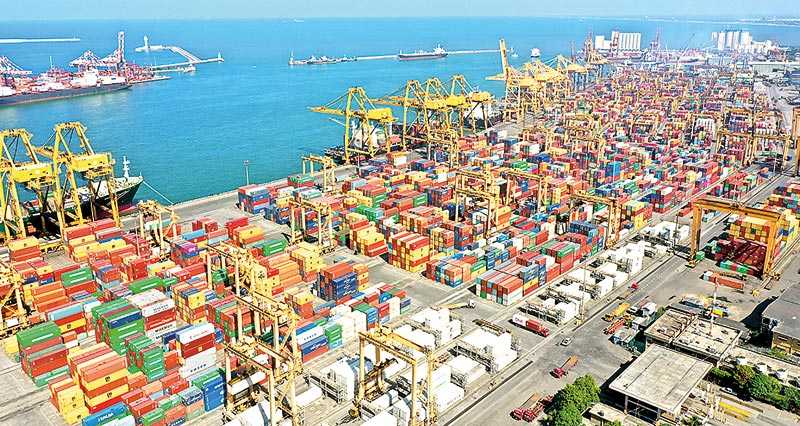Monday Apr 21, 2025
Monday Apr 21, 2025
Monday, 10 May 2021 00:00 - - {{hitsCtrl.values.hits}}

There are multiple and complex market forces that have caused the shortage of containers and the corresponding spike in freight rates. It is a vicious cycle to say the least
By Tania Polonnowita Wettimuny
 These are unprecedented times. Never, in the history of human existence has the world been brought down to its knees by a virus, sans the Spanish Flu – but that was at a time when the global business world was not at the current scale of interdependence. This pandemic has proved to be a colossal standalone business risk and an amplifier of existing trends and vulnerabilities.
These are unprecedented times. Never, in the history of human existence has the world been brought down to its knees by a virus, sans the Spanish Flu – but that was at a time when the global business world was not at the current scale of interdependence. This pandemic has proved to be a colossal standalone business risk and an amplifier of existing trends and vulnerabilities.
The outbreak of COVID-19 highlights cracks in global trust, the pitfalls of global interdependency and the challenge for global governance. These vulnerabilities have penetrated not only into the logistics industry but has proven detrimental to the entire gamut of manufacturing, trading, retail, and service businesses. And not a single country has proven immunity.
Soaring international freight rates and a shortage of containers has been a point of discussion since the outbreak of the pandemic. As key stakeholders in the shipping and logistics industry, it is imperative that we understand and analyse this area to build a response strategy plan within our organisations, ultimately providing a national framework. The global shipping industry will have to be at the forefront of efforts towards a sustainable recovery, as a vital enabler of the smooth functioning of international supply chains. The industry must be a key stakeholder helping adapt ‘just-in-time efficiency’ logistics to ‘just-in-case’ preparedness.
There are multiple and complex market forces that have caused the shortage of containers and the corresponding spike in freight rates. It is a vicious cycle to say the least. Approximately 80% of the goods we consume are moved by ships. Container rates have a particular impact on global trade, since almost all manufactured goods – including clothes, medicines, food and lifestyle products – are shipped in containers. In keeping with the laws of economics, the decreased supply of containers has driven freight rates upwards. The burden is borne eventually by the consumer. Businesses are not able to withstand increased costs and pass them on to their customers as the only way of sustaining their businesses.
Only time will tell if the cause of high freight rates has been the case of opportunism, resulting in rationalisation of shipping capacity by mega carriers. This can be compared with the infamous ‘fuel surcharge’ levied by airlines in the recent past, which was ultimately met with class litigation action ending in a landmark court judgement falling foul of anti-trust laws.
So, what exactly is the cause for this unprecedented shortage in containers?
Contrary to popular expectation, the demand for container shipping increased tremendously during the early stages of the pandemic, albeit after a brief initial slowdown. This was precipitated by soaring airfreight rates and lack of passenger flight belly capacity. The inability to visit physical stores and the boredom brought on by global lockdown measures, contributed to a surge in e-commerce and an increased demand in manufactured consumer goods – a large part of which is moved by shipping containers. As governments eased the first wave of lockdowns, approved economic stimulus packages and businesses stocked up on goods in anticipation of subsequent waves, there were further increases in maritime trade flows. According to the United Nations Conference on Trade and Development (UNCTAD), the increase in demand was more than expected and not met with an equilibrium in supply of shipping capacity. Subsequently, this led to the severe shortage in empty containers. Bare containers found themselves in ports that were not needed and where repositioning had not been given any prior thought.
Delving into this subject further brings to light other reasons for this shortfall. The COVID-19 pandemic and its effect on reduced labour, shifts and work from home orders, overall reduction in the number of ships, China’s recovery from the pandemic before the rest of the world, increased demand from the US due to the Christmas season, and the decline in US land freight capacity has had a significant role to play in the global container shortage.
The Corona virus slowed down the world’s economies in ways which were never experienced before. The initial restrictions, border controls, social distancing measures and lock downs placed in multiple countries severely affected the workforce, making the concept of ‘work from home’ a commonplace term. Within the shipping industry, restrictions brought about measures such as reduced number of port laborers, changes in shifts and overall reduction of employees at any given time. Additionally, manufacturing plants temporarily shut down causing a large backlog on import containers at ports around the world.
Reduced business volumes caused shipping lines to decrease the number of ships on their regular routes to balance costs and sustain business in the short term.
China’s recovery from the pandemic was swifter compared to other countries. Whilst China was strategising on recovery, most other countries were facing complete lockdowns from April to June 2020. Exports resumed when Chinese manufacturers started production. The fact that China, the world’s largest exporter, managed the coronavirus fast and resumed production earlier compared to other countries led to an increase in exports from China. Once other Asian countries exports started their recovery process, all remaining containers in Asia headed out to Europe and North America, but those containers did not come back quickly enough.
The period from September to November generally witnesses the peak of imports in the United States, owing to Thanksgiving, Black Friday and Christmas. Approximately 900,000 TEU’s are sea freighted from China to the US during this time. The seasonal traffic and the pressure exerted on Chinese production due to a weeklong holiday in lieu of National Day in the first week of October caused China’s export volumes to peak. Added to the fact that liners reduced their overall services and ships, the industry was severely affected with slowed down container turnaround time.
The final catalyst that added to this global shortage was the decrease in the workforce and infrastructure of land transportation in the US, due to the coronavirus. The truck driver shortage had an adverse effect on container turnaround time back to port. Containers that were expected to return empty in a day or two under normal conditions, could not be returned for weeks, exacerbating an already ticking time bomb. Containers were stuck at U.S. ports for weeks due to the insufficient availability of truckers and drivers. Simultaneously, the demand for American and European goods from Asian markets declined, leading to an uneven trade flow. Containers are still stagnant in certain countries that are experiencing lock downs. The weeklong incident with the Ever Given in the Suez in March, further compounded the problem, triggering a renewed increase in freight rates.
Simply put, demand has outpaced the availability of containers on a global scale.
There has been a lot of rhetoric on whether increasing overall container production and adding to the existing stock would provide a simple solution. Unfortunately, this is not the most sensible answer. 80% of containers in the world are made by three dominant companies in China. There has been a 6-8% increase in production since the pandemic but this production is not fast enough to meet the capacity crunch. Increasing production may ease the burden slightly, but the fact remains that efficient turnaround time of empty containers are not being met at ports globally. Until this is brought under control, the shipping industry will be faced with great uncertainty. There is much speculation about the emergence of new platforms which will facilitate container interchange enabling usage of containers on a one-way lease basis. However, the efficiency of such exchange platforms and how well they respond to levelling out container imbalances, is yet to be seen.
Thus, is there light at the end of the tunnel for our businesses?
We are facing uncharted waters never experienced by our business community before. We are all trying to figure out what this transition process looks like. Experts are of the view that this trend is likely to continue until the end of the year or the first quarter of 2022, when trade and business start witnessing a semblance of normalcy.
Various measures are being taken at a micro-level to ease the stalemate, such as more efficient unloading systems and reduction of detention periods at ports. It is speculated that contract freight rates will also remain high for the rest of the year.
The fact remains that we do not exactly know how this story will unfold. The rest of the year will be plagued with uncertainty and challenges will be far and wide for logistics companies and the greater economy in general.
One thing remains certain amidst much uncertainty. Our businesses will have to be adaptable and agile in order to remain in the reckoning. This will require us to make tough decisions that enable us to maintain lean operations, exercise solid control on working capital and temporarily halt corporate extravagances.
We are a nation and an industry that has stood the test of time. Resilience is in our blood. We withstood a war that ravaged our economy for 25 long years, and we still remained strong. The pandemic will ease eventually, and we will emerge stronger. Until then, we must lead our teams with motivation and perseverance, knowing that we will, once again, see this tough time through.
(The writer is Past Chairperson of SLFFA.)
Discover Kapruka, the leading online shopping platform in Sri Lanka, where you can conveniently send Gifts and Flowers to your loved ones for any event including Valentine ’s Day. Explore a wide range of popular Shopping Categories on Kapruka, including Toys, Groceries, Electronics, Birthday Cakes, Fruits, Chocolates, Flower Bouquets, Clothing, Watches, Lingerie, Gift Sets and Jewellery. Also if you’re interested in selling with Kapruka, Partner Central by Kapruka is the best solution to start with. Moreover, through Kapruka Global Shop, you can also enjoy the convenience of purchasing products from renowned platforms like Amazon and eBay and have them delivered to Sri Lanka.
Discover Kapruka, the leading online shopping platform in Sri Lanka, where you can conveniently send Gifts and Flowers to your loved ones for any event including Valentine ’s Day. Explore a wide range of popular Shopping Categories on Kapruka, including Toys, Groceries, Electronics, Birthday Cakes, Fruits, Chocolates, Flower Bouquets, Clothing, Watches, Lingerie, Gift Sets and Jewellery. Also if you’re interested in selling with Kapruka, Partner Central by Kapruka is the best solution to start with. Moreover, through Kapruka Global Shop, you can also enjoy the convenience of purchasing products from renowned platforms like Amazon and eBay and have them delivered to Sri Lanka.